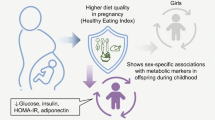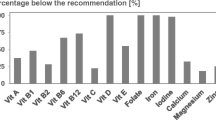Abstract
Male newborns are somewhat heavier than female ones and it has been reported, in a Caucasian population, that mothers carrying boys have higher energy intake during pregnancy compared to those carrying girls. In the context of a prospective study comprising 150 Caucasian women in Boston, USA and 243 Asian women in Shanghai China, energy intake at the second trimester of pregnancy was estimated based on center-specific food frequency questionnaires. There was a significant interaction (P = 0.01) of maternal height with offspring gender with respect to maternal daily energy intake. Among taller women, male gender of the offspring was associated with higher maternal energy intake (difference 341 kcal/day, 95% Confidence Interval 77–604; P = 0.01), whereas among shorter women, no significant association existed between offspring gender and maternal daily energy intake (difference −213 kcal/day, 95% Confidence Interval −479 to 54; P = 0.12). Our findings indicate that the higher somatic growth potential of boys in intrauterine life is realized only when there are no constrains imposed by maternal anthropometry and it is, then, associated with higher maternal energy intake during pregnancy.
Similar content being viewed by others
References
Van Vliet G, Liu S, Kramer MS. Decreasing sex difference in birth weight. Epidemiology. 2009;20:622.
Tamimi RM, Lagiou P, Mucci LA, et al. Average energy intake among pregnant women carrying a boy compared with a girl. BMJ. 2003;326:1245–6.
Lipworth L, Hsieh C-c, Wide L, et al. Maternal pregnancy hormone levels in an area with a high incidence (Boston, USA) and in an area with a low incidence (Shanghai, China) of breast cancer. Brit J Cancer. 1999;79:7–12.
Lagiou P, Lagiou A, Samoli E, Hsieh CC, Adami HO, Trichopoulos D. Diet during pregnancy and levels of maternal pregnancy hormones in relation to the risk of breast cancer in the offspring. Eur J Cancer Prev. 2006;15(1):20–6.
Lagiou P, Samoli E, Lagiou A, et al. Maternal height, pregnancy estriol and birth weight in reference to breast cancer risk in Boston and Shanghai. Int J Cancer. 2005;117:494–8.
Xue F, Willett WC, Rosner BA, et al. Parental characteristics as predictors of birthweight. Hum Reprod. 2008;23:168–77.
Willett WC, Sampson L, Stampfer MJ, et al. Reproducibility and validity of a semiquantitative food frequency questionnaire. Am J Epidemiol. 1985;122:51–65.
Romieu I, Stampfer MJ, Stryker WS, et al. Food predictors of plasma beta-carotene and alpha-tocopherol: validation of a food frequency questionnaire. Am J Epidemiol. 1990;131(5):864–76.
Yang Y, Wang G, Pan X, editors. China food composition table 2002 (Book 1). Institute of Nutrition and Food Safety, China CDC. China: Peking University Medical Press; 2002. p. 1–395.
Yang Y, Wang G, Pan X, editors. China food composition table 2004 (Book 2). Institute of Nutrition and Food Safety, China CDC. China: Peking University Medical Press; 2004. p. 1–351.
Serdula M, Byers T, Coates R, et al. Assessing consumption of high-fat foods: the effect of grouping foods into single questions. Epidemiology. 1992;3:503–8.
Nelson M, Bingham S. Assessment of food consumption and nutrient intake. In: Margetts BM, Nelson M, editors. Design concepts in nutritional epidemiology. 2nd ed. New York: Oxford University Press; 2000. p. 147.
FAO Food and Nutrition Technical Report Series. Human energy requirements. Report of a Joint FAO/WHO/UNU Expert Consultation. Rome, 17–24 October 2001. p. ix + 96.
Cawley RH, McKeown T, Record RG. Parental stature and birthweight. Am J Hum Genet. 1954;6:448–56.
Emanuel I, Kimpo C, Moceri V. The association of maternal growth and socio-economic measures with infant birthweight in four ethnic groups. Int J Epidemiol. 2004;33:1236–42.
Acknowledgments
This work was supported by the W81XWH-05-1-0314 Innovator Award, US. Department of Defense Breast Cancer Research Program, Office of the Congressionally Directed Medical Research Programs.
Author information
Authors and Affiliations
Corresponding author
Rights and permissions
About this article
Cite this article
Lagiou, P., Samoli, E., Lipworth, L. et al. Energy intake during pregnancy in relation to offspring gender by maternal height. Eur J Epidemiol 26, 39–44 (2011). https://doi.org/10.1007/s10654-010-9528-3
Received:
Accepted:
Published:
Issue Date:
DOI: https://doi.org/10.1007/s10654-010-9528-3




